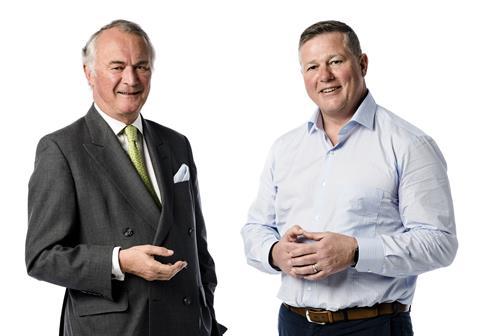Stephen Catlin and Paul Brand are back and making waves already with their new start-up venture Convex. Insurance Times spoke with the pair to discuss why they are getting back in the game and why they have a specific advantage over rival insurers
Stephen Catlin may have just turned 65, but he shows no sign of slowing down.
At the age most people are starting to claim their state pension, Catlin on the contrary is diving back into work with a new start-up venture.
But if Convex is to be his insurance swansong after a long and successful career, then he wants to go out on a high.
Convex, co-founded by Catlin and his long-time colleague Paul Brand, is the biggest insurance start-up of all time.
The new insurer launched at the beginning of May with $1.8bn of initial committed capital. The firm will draw down $1.6bn to start business. It’s testament to the pair’s reputations in the market that they were able to source so much capital for a start-up.
“When I stepped down from XL Catlin I had no idea what I wanted to do,” Catlin told Insurance Times. “But as time progressed, a number of things came together. One, a lot of brokers were saying to us ‘why don’t you two get back in the market, we could do with you two being around’, so we knew we had support from providers.
“And two, a number of bank advisers said to us ‘we believe you two can raise money in a way that most other people can’t’ and that we should think about it.”
Building the ‘toolbox’

But it’s not just in financial capacity where Catlin and Brand have attracted support.
The pair have been successful in attracting a number of former Catlin and XL Catlin colleagues.
“We have been absolutely inundated with people ringing up asking if they can talk to us,” Catlin said. “It’s the most humbling experience. A day doesn’t go by when we don’t have someone call up asking to talk to us.”
As many of the employees they are signing up have to give six months notice, Catlin said 2019 was about building the “toolbox” to write a broad range of classes from the start of 2020.
He wouldn’t be drawn on premium targets, but did say he expected to have 100 people working for Convex by the end of 2019. By the end of 2020 he expects it to be 200 people.
But Catlin and Brand believe Convex has a competitive advantage over its rivals that could see growth come quickly.
Having been freed from their contractual duties to XL Catlin with AXA’s agreement to buy the company, in March 2018, Catlin said he was further encouraged to press ahead with a new venture when three days after the acquisition Lloyd’s announced heavy market losses.
“We took the view that the headwinds the market had experienced over the last ten years were probably going to change into gentle tailwinds, so why not take advantage of the opportunity,” Catlin said.
Market opportunity
Convex will focus on complex specialty lines of business, with 60% of the book insurance, and 40% reinsurance. Convex won’t have a Lloyd’s syndicate to begin with, but Catlin said he is full of support for John Neal’s work overhauling Lloyd’s, and said it was an option he and Brand may revisit in the future.
For now, the business will be serviced from offices in Bermuda and London, with 80-90% of staff in London.
“It’s clear that there is a vacuum of leadership both in Bermuda and in London,” Catlin added. “The market is in a state of flux. There is a lot of consolidation going on and we feel there is a hole there which we can part fill.”
He said Convex can particularly benefit over rivals through an absence of longtail drain from legacy accounts. This drag on the books of many established insurers is a key factor in the continual firming of the marketplace, according to Catlin.
“We’re starting legacy-free both in terms of liability insurance claims, and in terms of process,” Catlin said.
“Both those two legacies are going to be a noose around the neck of many carriers for the next five to ten years, so in that respect we have a fantastic advantage.”
Advantage
And Brand is equally optimistic about the prospects lying before them.
“There is a huge opportunity for the industry to be more client-focused, and to really think what their clients need and deserve, and concentrate on delivering that,” Brand said. “There are things that we can do that other companies are not doing.”
He said Convex would use data and analytics from the start to build resilient portfolios focused on driving a profit.
“We’ll build a decision-making advantage from the use of those techniques,” Brand added. “Work is progressing on all those fronts. Because of our operating structure we can do all of that at a cheaper cost than the competitors.”
But more than anything, it could simply be the experience of Catlin and Brand that gives them their real competitive advantage.
And the most important thing for a start-up like Convex, according to Catlin, is not to prioritise volume with overly competitive pricing.
“At the time of the sale of Catlin to XL, we’d been the largest Lloyd’s syndicate for about 12 years, and we’d had over half of our business in the Lloyd’s market, which was considerably more than anybody else,” he said. “We didn’t get leadership solely on price. We got it on service, and we got it on claims payment capability and the speed of paying claims.
“We got there on the back of people knowing us and trusting us to be consistent and transparent, and we’ll be carrying on that same theme moving forward.”
Humble beginnings
Catlin could write the book on insurance, and indeed he has (published in 2017). From starting out in the industry 45 years ago and setting up Catlin aged 30 in 1984, Catlin has scaled from the bottom right to the top.
But with his latest start-up, he says the situation is very different.
“When I started Catlin there were two people and £25,000 paid up capital, no distribution, no real reputation and very little resource. It’s a whole different boardgame this time around where we have everything the opposite,” he said.
In spite of this, there are still lessons that Catlin picked up when establishing his first business that he says will be useful.
“What we have both learned through the years is that people matter,” he said. “And how you treat people counts, and being fair, honest and transparent makes a difference.
“That applies both internally and externally. It applies not just to staff, it applies not just to client and to broker, but it applies to regulator, to analyst, to rating agency, and everyone you deal with.”
Lessons learnt
By learning from their past experiences and mistakes they plan to make Convex a trusted carrier that brokers and clients want to use.
However, Catlin and Brand are also eyeing making a bigger impact on the market as a whole to improve the way business is done.
Catlin said the market is currently “unsustainably inefficient” and that it can’t go on.
“We want to be part of making the industry more efficient than it is today,” he added. “Without having legacy it’s easier to be at the front of the curve on this.”
And with the support Convex is attracting, along with the track records of Catlin and Brand, the company could be the single most important start-up involved in shaking up the market next year.
“Our main challenge is not letting ourselves be dragged back by gravity into doing things the same way that everyone else has,” Brand said. “The world is very different today, and if you don’t change your processes and how you approach doing business then you are going to miss out.”
Subscribers read more
Hiscox bosses reveal where rates are rising in retail and London market businesses

Hosted by comedian and actor Tom Allen, 34 Gold, 23 Silver and 22 Bronze awards were handed out across an amazing 34 categories recognising brilliance and innovation right across the breadth of UK general insurance.




















































No comments yet